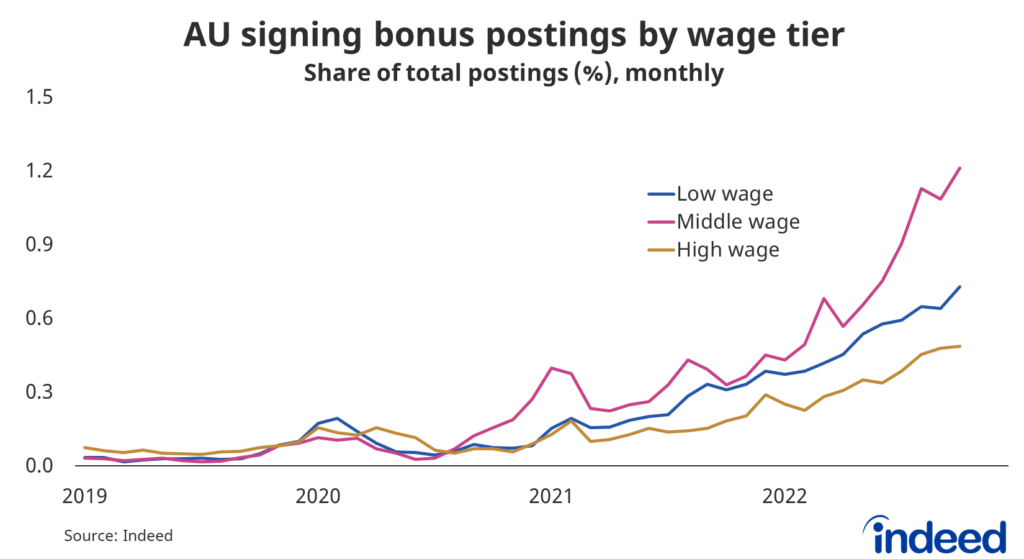Key Points
- The share of Australian job postings noting signing bonuses almost tripled in the year ending October 2022, coinciding with significant labour market tightening.
- Signing bonuses are heavily concentrated in occupations typically performed in-person, reflecting the additional incentive required to lure jobseekers away from the comforts of home.
- Signing incentives have grown strongly across middle-wage sectors and are most common in nursing, beauty & wellness and physician & surgeon jobs.
With the Australian labour market as tight as seen in nearly a half century, employers are experimenting with ways to attract more talent. One method is offering prospective workers a signing bonus as a hiring incentive.
Unlike the United States, signing bonuses haven’t traditionally been common among Australian recruiters. However, with Australia’s job vacancy rate now more than twice pre-pandemic levels, some employers are turning to offers of cash and other bonuses to entice workers.
To assess the frequency of signing bonuses, we tracked references to them in job descriptions posted on Indeed’s website. Our results aren’t a comprehensive measure of how many employers offer signing bonuses — some don’t reveal or decide to use a signing bonus until later in the recruitment process. But it does show how often signing bonuses are used as a selling point in job ads aimed at prospective employees.
Overall, the advertisement of signing bonuses soared during the pandemic, with growth particularly evident in middle-income occupations and jobs where remote work is difficult. Evidently, some employers need additional incentives to lure prospective recruits away from the comforts of home.
Postings noting signing bonuses have surged throughout pandemic
In October, 0.8% of job postings on Indeed’s Australia site explicitly contained the expression signing bonus or a similar phrase in job descriptions. That’s almost three times higher than a year ago and 14 times higher than in October 2019, before the pandemic. Until COVID-19 hit, a signing bonus was rarely part of a recruiter’s toolkit and largely irrelevant for most occupations and industries.
The stunning improvement in Australia’s labour market has changed that. As competition for talent heated up, underpinned by an historically low unemployment rate, employers were forced to find new ways to differentiate themselves. Jobseekers suddenly had greater control over where and how they worked, and were in much stronger bargaining positions. In such an environment, employers have increasingly offered signing bonuses to find the workers they need.
Signing bonuses used to attract jobseekers to in-person roles
The sharp rise in use of signing bonus has been concentrated in roles typically performed in-person and difficult to do from home. In October, 0.8% of job postings for low-remote and medium-remote sectors featured signing bonuses, roughly 4.5 times higher than for high-remote positions.
It’s not hard to understand why employers in industries or sectors where remote work is less prevalent need to resort to signing bonuses and other benefits to attract jobseekers. A recent study found 35% of Australians said they would quit their jobs or start looking for another if their employers forced them to return to the workplace full-time.
Before the pandemic, signing bonuses were actually 2.5 to 3 times more common in high-remote sectors such as tech or engineering than in low-remote or medium-remote sectors. To be sure, signing bonuses were uncommon then. To the extent they could be found, they were concentrated in white-collar positions, many of which were easily performed from home. That’s been turned on its head during the pandemic recovery.
Jobseekers looking for middle-income roles most likely to benefit
Growth in signing bonus has also been heavily concentrated in middle-income sectors, such as nursing. In October, 1.2% of middle-income job postings on Indeed referred to signing bonuses, compared with 0.7% of low-wage and 0.5% of high-wage roles.
Before the pandemic, signing bonuses were more common in high-wage jobs, albeit with very low prevalence. This pre-pandemic concentration at the high end of the wage scale was consistent with such bonuses appearing more often in ads for high-remote, white-collar positions.

Signing bonus incentives are most common in healthcare and related sectors, led by nursing, where 3.4% of job ads from August to October offered a bonus, ahead of beauty & wellness at 3.3% and physicians & surgeons at 3.2%. Around 2.3% of postings for dentists offered signing incentives. Medical information at 1.7% and personal care at 1.5% also ranked highly.
Outside healthcare, signing incentives were relatively common in installation & maintenance roles at 1.5%, sports at 1.4% and community & social services, also at 1.3%.
Conclusion
Australia’s labour market is incredibly tight. The unemployment rate is at a near-half-century low and the nation’s job vacancy rate is more than twice as high as before the pandemic. This extraordinary job market has forced recruiters to explore new tactics to attract jobseekers.
Signing bonuses are clearly one such tactic. While references to them don’t appear in a large share of Australian job postings — just one in every 130 job ads — their sharp rise is striking.
The proliferation of signing bonuses is yet further evidence of how favourable today’s labour market is for jobseekers. Those looking for work have taken advantage of this, pushing job-hopping to a decade high. Job opportunities are plentiful across virtually every sector and industry. On top of that, workers have better chances of snagging higher wages and — with the spread of signing bonuses — even a big lump sum payment.
Methodology
Signing bonus job postings are defined as those that include terms like “signing bonus,” “sign on bonus,” “signing incentive,” or “bonus for signing on” in the job description.
Classifications such as low- or high-remote are based on the frequency of remote postings in each occupational category prior to the pandemic. Wage tiers are determined by ordering each occupational category from highest to lowest wage based on wages published on Indeed in 2019.



